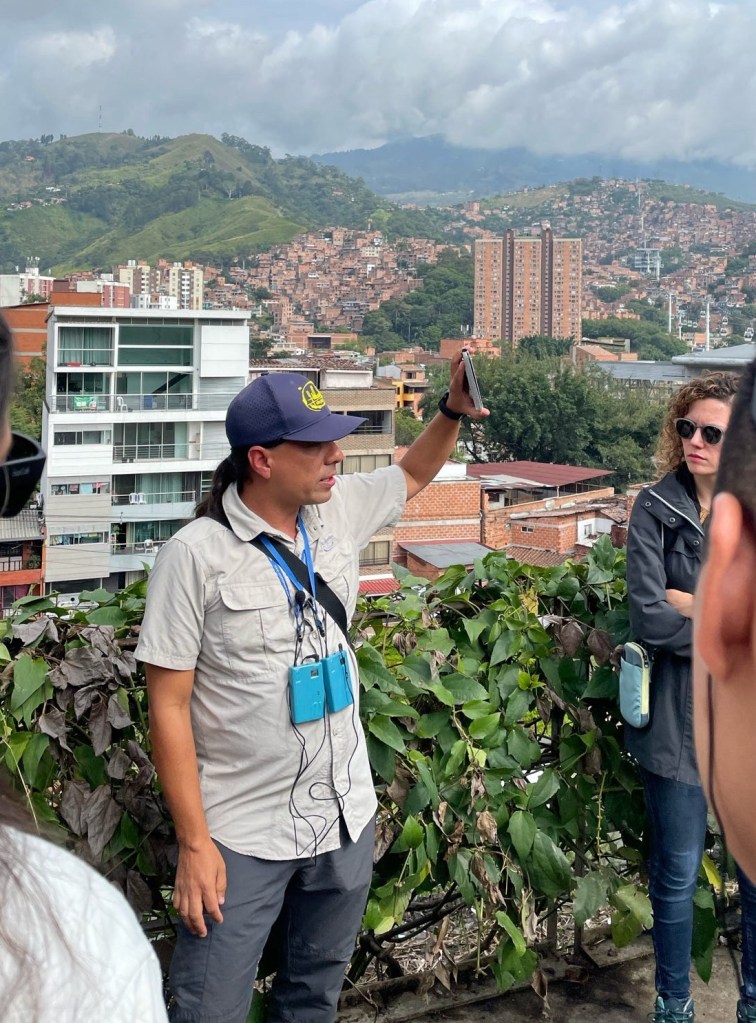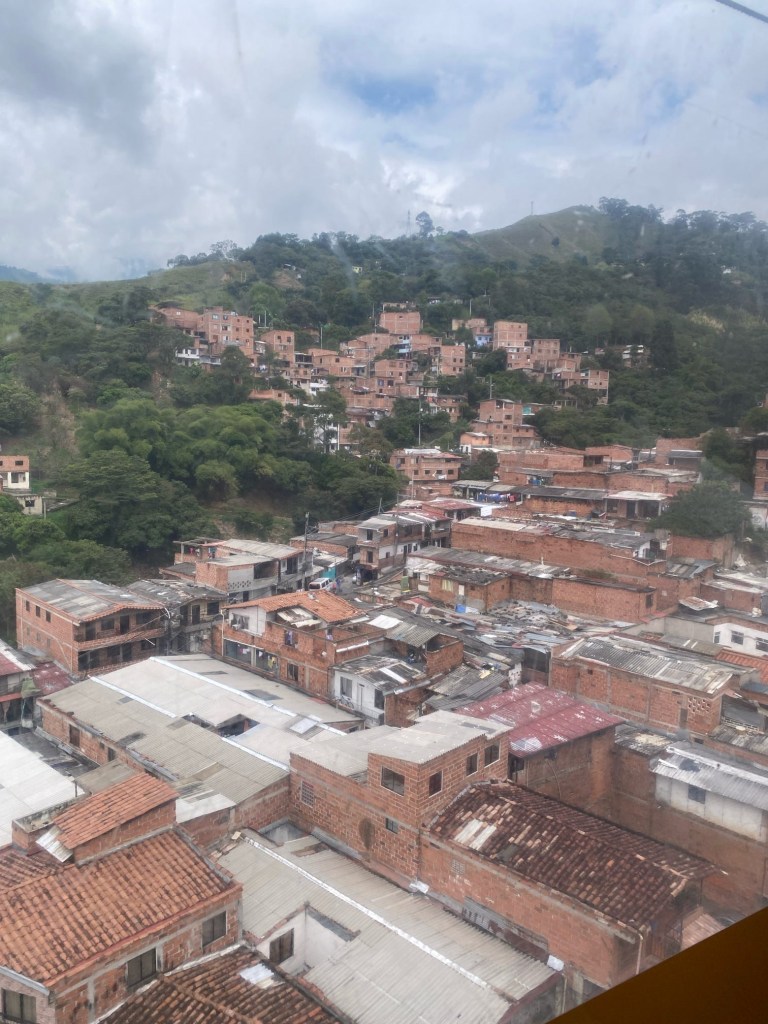The last day in Medellín left a permanent, deep imprint on our hearts. There was no way we could have predicted the gravity and intensity of what we were about to experience. Our guides Jaime and Juliana threw open a window and invited us to step in their shoes and see what it was like to grow up in Medellín during the 1980s, 1990s, and 2000s. The day’s activities included a tour of Comuna 13, one of the 16 communities (comunas) built by hand onto the steep mountainsides surrounding Medellín.
We found ourselves immersed in rich and complex culture, enveloped by a community with open hearts full of hope, perseverance, and resilience; but the story of the Medellín people, the Paisas, was not easily forged. The path taken is reflected in the many steep, winding, and complex corridors, stairways and constant evolution of the comunas. Improvised by a million people spanning decades, carved into the mountainsides by people who continually pushed forward, it is easy to see both the care and cost invested to create the community that welcomed us today.
The day’s activities were planned in such a way that we grew with the Comuna, building our knowledge brick by brick, experiencing this place both physically and emotionally which is taking time to fully process. The fall of Pablo Escobar left a void for guerrillas and the paramilitary forces to skirmish over power and fight against each other. Just as the exhausted community was ready to heal and move on from constant violence of the cartels, a new war was born. The experiences shared by our guide, Jaime, who was a young teenager in the 1990s and who only knew a life of normalized violence, was incredibly special. Thank you, Jaime, for your vulnerability and the trust you placed in Class 52 to share your story so openly.

Comuna 13 was a strategic location for transportation of goods to the distant port, making it a critical point of control for the city’s commerce. The topography and construction of the comuna made it severely difficult for police forces to regulate as guerrillas and paramilitary forces reigned throughout the community. However, the ensuing war waged differently from the time of Escobar. Short range 9mm guns were replaced with large caliber military rifles. Neighborhoods far away now found themselves down range. Bullets traveled further and resulted in more collateral damage with increasing numbers of innocent civilians killed or wounded. After several failed attempts, the president ultimately partnered with paramilitary groups and on October 16, 2002, a three-day operation resulted in success and the guerrillas were defeated. However, the lasting effects of this war are still apparent in the comuna and in politics today.
The next inflection point in Medellín’s story then commenced. With a functioning metro system, Medellín expanded service to the comunas by building six cable lines (gondolas) to provide a quick 20 minute ride into the city center. Jobs were accessible, thus crime diminished and people took pride in their new-found connection and inclusion with the rest of Medellín. Alleviating the worry of the more affluent communities, the “metro culture” was not just adopted but enforced by the less affluent neighborhoods in the comunas. It would be nearly impossible to find a system as clean and well-taken care of in our country.

As Class 52 crossed the bridge to San Javier Station, we saw Jaime’s elementary school. The children were out on recess and their joy was infectious. With hearts full, we entered the cable cars/gondolas and travelled with a birds-eye view over the neighborhoods. We saw the full spectrum of development and how these areas sprawled across the terrain over time – first starting with wooden structures, then upgraded with red cinder blocks made from local clay. Houses grew as families grew and migrants arrived – new levels were added, stacked on top of each other. We saw families greeting each other on doorsteps; grandsons bending to kiss their grandparents hello before crossing the threshold. Little glimpses of love, joy, and kindness – a perfect representation of the strength and resilience of the comuna.

Our guides led us to the place where paved roads ended and we entered the world footpaths, towering stairs, and allies filled with people and motorcycles. We were surrounded by culture – from hip-hop to reggaeton to frozen fruit pops (cremas), to beautiful mural paintings covering the walls and buildings. This place was alive and vibrant. The smells of incense, food cooking in shops and restaurants, perfume of a passing stranger; street entrepreneurs calling out with goods for sale – water, beaded bracelets, empanadas, the options seemed endless. We explored, looking to support the economy and find something to memorialize our experience, not knowing that the strongest memory lay ahead at lunch.
We were invited to share an authentic home-cooked meal in a community kitchen that served children and other vulnerable persons for free or very low cost. Our lunch was beautifully and lovingly crafted: a traditional meal of rice, beans, plantains, avocado, onion, tomato, and shredded beef. The aroma filling the small dining room reminded many of us of our own mothers’ kitchens. The love poured into this meal nourished our bodies and our souls, and one class member was heard saying “this was the most delicious meal of the trip.”

Sharing food with others has a remarkable ability to forge strong relationships. Today was no exception. The kitchen was new – established only six months ago by the Comuna Project Foundation – and never before had they served a group outside of the comuna. During our visit, children popped in for a meal and were greeted in the same manner as us – like a child who had come home. They, like us, found not only food, but genuine love through gift of self. Diana, one of our Presiding Fellows for the day, stated that the leaders at the kitchen were the perfect representation of CALF core values – respect, integrity, and excellence. Diana’s words of appreciation for Alma, Marisol, and Santiago came from the heart, and many joyful, grateful tears were shed. There’s a saying in Spanish: “Barriga llena corazon contento” which means “full belly happy heart”, and it could not have been more true than when we were with the Comuna Project crew.
The gift of self – something that costs so little – can have the greatest impact.
Our last visit of the day brought us to Capilla del Rosario, a local artisan coffee farm nestled just below the top of the mountain range above Medellin at 4,000 ft. We learned about coffee production in Colombia, which faces similar challenges to farms and ranches in California – invasive pests, succession planning and labor. With 65,000 coffee trees requiring 50 field workers and only 15 showing up, they demonstrated that proximity to the employment opportunities afforded by the city made it difficult to compete in the labor market. Many of us could relate to his final comments on the future of agriculture in Colombia. The average coffee farmer is 69 years old, and Capilla del Rosario has invested their resources to provide education for local growers looking to create specialty coffees and entrepreneurship.

The day ended with synthesis, which was an incredibly special moment for us because the class decided as a group to amend a tradition and invite both of our tour guides, Jaime and Juliana, to join us. They shared so much of themselves, we felt it would be an appropriate way to honor their gift with something that cost us nothing but means so much.
We’ll leave today with a quote from Jaime:
“This time I found human beings, the real person, not the regular tourist. It was beautiful. Your mission is to grow leaders to make a difference. You are making a difference. These three days, you have made a big impact on the people you came in contact with. We are going to be thinking about you for a long time.”


Leave a comment